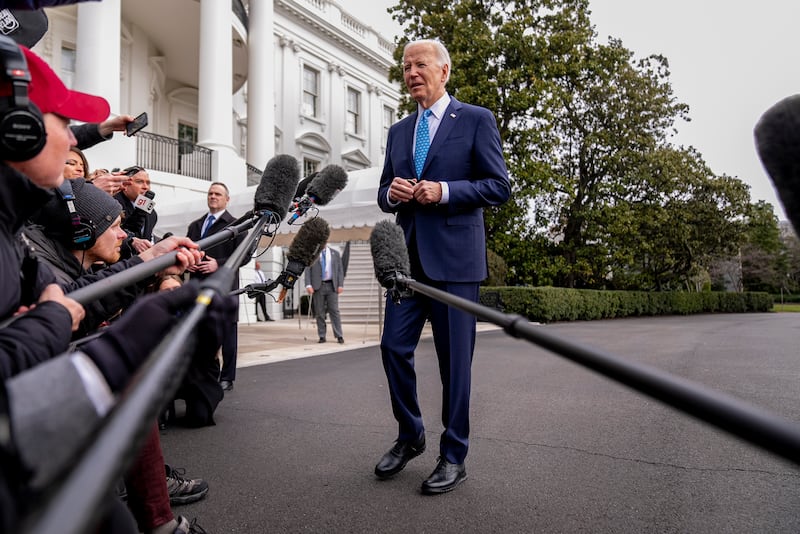On Tuesday morning US president Joe Biden left the White House for a series of fundraising events in Florida and paused to tell reporters that he had decided on how to exact an appropriate military response to Sunday’s attack on a US military base in Jordan, which killed three American military personnel.
By then, the names and faces of the three army reservists from Georgia were flashing across the morning television news shows. Sgt William Rivers (46) from Carrollton, Breonna Moffett (23) from Savannah and Kennedy Sanders (24) from WayCross had all been assigned to an engineering company based at Fort Moore.
Their deaths mark the first fatalities through what has been a barrage of strikes by Iran-sponsored proxy militia forces against US troops stationed in the Middle East since October. On Monday, a spokesman for Iran’s foreign ministry, Nasser Kanaani, sought to distance it from responsibility for the drone attack on Tower 22, arguing at a news conference that such militia groups “do not take orders” from Iran and act independently, and stating that the “unfounded allegations against Iran” suits those who “see their interests in once again getting the US involved in a new conflict in the region”.
In his brief morning exchange, President Biden placed responsibility with the Iranians “in the sense they’re supplying weapons to the people who did it”.
RM Block
“I don’t think we need a wider war in the Middle East. That’s not what I’m looking for.”
Until Sunday, the US government had tried to manage the series of attacks — at least 165 — with low-key strikes on the proxy forces. These measures have failed to deter the activity of the various militia, and the deaths of the three Georgia military members necessitate a more explicit and sterner US response.
There is uniform agreement that the option for such a response is threefold. The boldest and most high risk would involve retaliatory strikes at targets inside Iran. An alternative is a series of strikes against Iran’s assets. The mildest response would be limited to diplomatic sanctions.

The consequence of a strike within Iran is stark and would leave the US in a position which the Biden administration has explicitly stated it wishes to avoid.
“You effectively put the United States at war with the Islamic Republic of Iran,” outlined retired Brig Gen Mark Kimmitt in an interview on Tuesday.
“The targets ... may not be nuclear, but their revolutionary guard’s headquarters, facilities, high-value personnel targets. It goes beyond a fight against the proxies and becomes a fight against the government of Iran.”
The more likely option is a series of bespoke attacks, similar to the air strike carried out on January 4th on a logistical support centre in Baghdad which according to the Popular Mobilisation Force – a coalition of militias – killed its deputy head of operations, Mushtaq Talib al-Saeedi, who was also leader of the Iran-backed militia Harakat al-Nubjaba.
It is also possible that the US will engage in back-channel messaging with Iran as occurred in 2020 after the Trump administration killed prominent Iranian general Qasem Soleimani in a strike at Baghdad airport, and shortly afterwards delivered an encrypted message to the Islamic government via the Swiss embassy in Tehran, warning against escalating tensions between the countries.
The dilemma for President Biden and his advisers involves executing a response that will serve to subdue the emboldened militia activity in the region, send a clear warning to Iran without provoking another international conflict and respond to the Republican accusations, led by Donald Trump, that the latest military deaths are a reflection of a weakness of the foreign policy decisions of his administration.
“We have to make sure we don’t set off a cascading effect of unintended consequences because ... when you are commander in chief, actions have consequences,” said Jason Crow, the Democratic member of congress for Colorado who served with the US army in Iraq and Afghanistan.
Hinting at what is to come, White House national security spokesperson John Kirby said on Tuesday that “it is very possible what you’ll see is a tiered response here, not just a single action but essentially multiple actions”.
Gauging the severity of the actions against the threat of further complicating a volatile region will be key to the success of the US response.
- Sign up for push alerts and have the best news, analysis and comment delivered directly to your phone
- Find The Irish Times on WhatsApp and stay up to date
- Our In The News podcast is now published daily – Find the latest episode here














